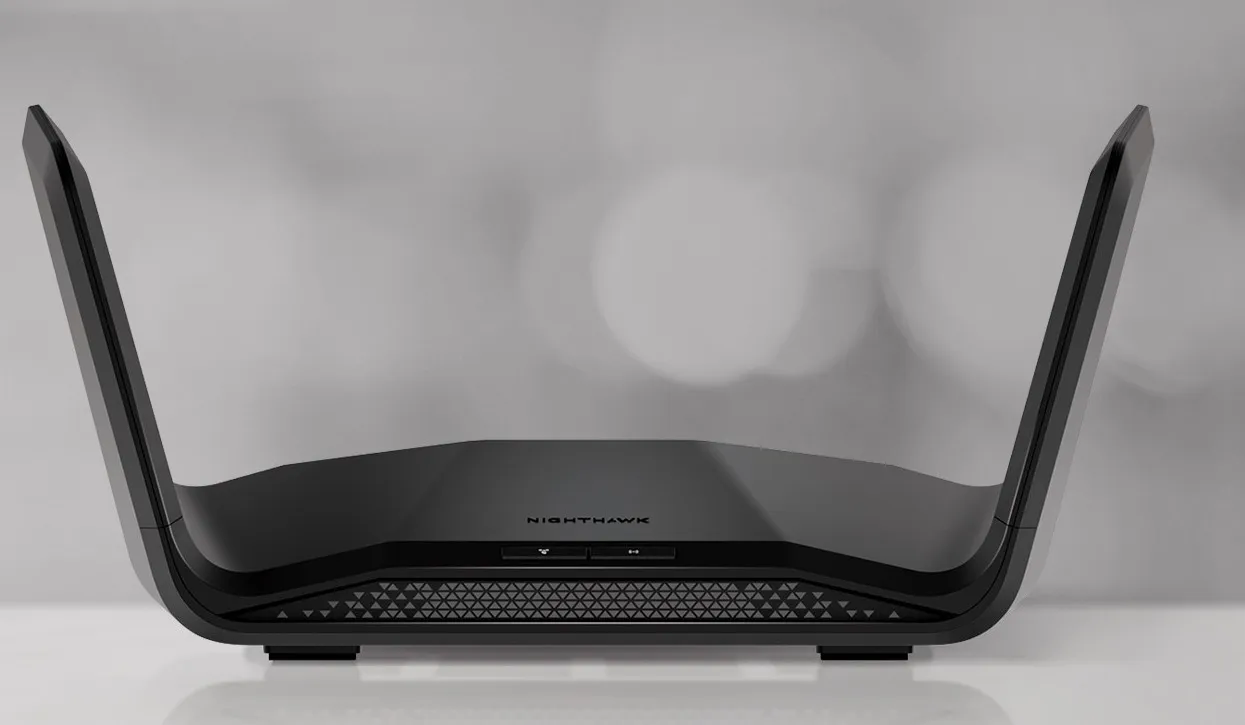

Netgear's Nighthawk series caters to a wide range of networking needs. The series includes high-end gaming routers with specialized DumaOS software for gamers seeking optimized latency. The Nighthawk RAXE300, however, targets mainstream users requiring fast and reliable Wi-Fi. It offers a 7.8 Gbps speed and Wi-Fi 6E technology without the complexity of gaming-oriented features. This router stands out in the market despite its premium price point and the additional cost for extended parental controls and security features.
The Nighthawk RAXE300 boasts a design that departs from typical gaming routers. It features a unique low-profile look with foldable wings that conceal its antennas, resembling a compact space shuttle. The device commands attention with its expansive wingspan and streamlined interface, which includes essential buttons for Wi-Fi and WPS functions. This design choice emphasizes simplicity and a clutter-free user experience.
This router is not just about looks; it's built to perform. It houses a 1.7GHz Quad-Core processor, 512MB DDR4 DRAM, and 256MB flash storage. Connectivity options are ample, with various Ethernet ports and a USB-C interface for network flexibility. The RAXE300 supports the latest Wi-Fi 6E standard, ensuring compatibility with new and future devices. It aims to provide a balance between advanced technical capabilities and user-friendly operation for a diverse user base. In this article, we will dive into some of its features and why it can be a great router for your home and office use.
Design and Build
The Nighthawk RAXE300 router presents a distinct aesthetic. It forgoes the typical gamer-centric design with flashy lights and external antennas. Instead, it adopts a more subdued appearance with a set of folding wings that house its internal antennas. This choice gives the router a sleek, space-saving profile that makes it stand out visually. The router's size, with the wings fully extended, is considerable. Users need to allocate adequate space to accommodate its 346 mm width, 164 mm height, and 208 mm depth.

Netgear has designed the RAXE300 with a user-friendly interface. The front panel features only two buttons: one for WPS to connect devices swiftly and another to switch the Wi-Fi on or off. This design choice streamlines user interaction with the device. LED indicators for internet and band status are placed discreetly at the back. They remain unobtrusive but are accessible when needed to check the router's function.
Technical Specifications
The technical backbone of the Netgear Nighthawk RAXE300 is substantial, providing a foundation for its performance claims. Central to its operation is a 1.7GHz quad-core processor, which handles data processing efficiently, essential for reducing latency and managing multiple connections simultaneously. The router's memory capacity, with 512MB of DDR4 DRAM, allows for quick access to the most used data and instructions, while the 256MB of flash storage offers enough space for firmware updates and custom settings, ensuring the router's software is robust and upgradable.
Port selection on the RAXE300 is designed to cater to various networking needs. The inclusion of one Gigabit Ethernet port for WAN and an additional 2.5 Gigabit Ethernet port for WAN enhances its versatility, catering to high-speed internet plans and providing options for network bridging. The four Gigabit Ethernet LAN ports facilitate high-speed wired connections, essential for devices requiring stable connections like desktop PCs and gaming consoles. The USB-C 3.0 port is a modern addition, allowing for quick data transfers and the connection of external storage devices for network sharing.
Wi-Fi support on the RAXE300 stands out with its Wi-Fi 6E (802.11ax) capabilities, which encompass tri-band frequencies of 2.4GHz, 5GHz, and the latest 6GHz. The support for Wi-Fi 6E is a forward-thinking feature, ensuring the router is ready for the latest devices and can operate in the less congested 6GHz band, offering faster speeds and lower latency. The maximum speed potential of 7.8Gbps showcases its ability to handle ultra-fast broadband services and the demands of data-intensive tasks without compromising performance.
The router's dimensions are a reflection of its internal capabilities, with a footprint of 346 x 164 x 208mm, signaling that it's not a compact device but one that's designed to be a central and powerful home networking hub. Weighing in at 1.01kg, it has a heft that suggests quality and durability. The price tag, set at $399.99/£349.99, positions the Nighthawk RAXE300 in the higher-end bracket of home networking equipment, reflecting its advanced specifications and targeted audience looking for a premium wireless experience.
Setup Process
Netgear targets both tech-savvy and non-technical users with the Nighthawk RAXE300. The setup process is simplified through the Nighthawk app. The app provides a guided installation, making it accessible to a broader audience. For manual setup, the default network name and password are printed on the router's base. A QR code is also available for quick scanning, allowing for rapid mobile connection.
The app guides users through each step, from powering on the router to connecting to the internet. However, the RAXE300's tri-band functionality creates a complex setup for those unfamiliar with multi-band networking. By default, the app creates three separate networks for each frequency band. This may confuse users who are accustomed to single SSID setups. While the separation of bands can benefit performance allocation for tasks like gaming and streaming, Netgear could improve their guidance for new users in this area.
Features and Connectivity
The Nighthawk RAXE300 stands out for its robust wired connectivity options. The router provides a variety of ports to meet diverse networking demands. Two Ethernet WAN ports, one Gigabit and one 2.5 Gigabit, offer flexibility for different internet service speeds and setups. Additionally, four Gigabit Ethernet LAN ports are available for direct, wired connections to devices such as PCs, gaming consoles, and smart TVs, ensuring stable, high-speed internet access for bandwidth-intensive tasks. This wired connectivity is crucial for environments where wireless connections might be unreliable or for devices that require consistent bandwidth for optimal performance.
Network aggregation is a significant feature of the RAXE300, allowing users to combine two LAN ports to double the connection speed to a single device, which is particularly useful for activities like high-definition video streaming or competitive online gaming. This capability is known as link aggregation and can be beneficial for servers and NAS (Network Attached Storage) devices that support this feature, offering enhanced data transfer rates and reliability.
The inclusion of a USB-C 3.0 port adds a modern touch to the router's connectivity suite. This port can be used to connect external storage devices, turning the router into a de facto network-attached storage device, allowing for the sharing of files across the network. The USB-C connection offers fast data transfer rates, which is beneficial when streaming media from the connected storage or for conducting quick backups of large files.
While the Nighthawk RAXE300 hardware provides a wealth of features, the Nighthawk app's functionality for managing these features does present some limitations. The app simplifies the initial setup process and provides a basic overview of the network and connected devices. Users can easily change network names and passwords, and set up a guest network. However, the app lacks advanced options for configuring detailed network settings. It offers a Speed Test function to check the internet speed using the third-party Ookla service, but it doesn't test the local network's speed.
The app's simplicity, while user-friendly, means that some of the router's more advanced features, such as Quality of Service (QoS) adjustments, network aggregation settings, and file-sharing configurations for USB-connected devices, are not accessible within the app. Users needing to utilize these advanced features must resort to the web browser interface, which provides more comprehensive control over the network but is not as intuitive as the app. The browser interface is not promoted within the app itself, potentially causing users to overlook the full capabilities of their router.
Security and Parental Controls
The Nighthawk App delivers basic control functions that allow users to manage their network with ease. The app provides the ability to pause internet access on any connected device, an essential feature for managing family internet usage during key times such as dinner or bedtime. Yet, Netgear positions more advanced security and parental control features behind a paywall. Services like Netgear's Armor, which offers enhanced security, and Smart Parental Controls, which enable content filtering, come at an additional cost. Users can trial these services for 30 days, after which the Armor service requires a yearly subscription of $99.99/£82.00, and Smart Parental Controls offer monthly or annual payment options.
For those seeking more granular control over their network settings, the Nighthawk RAXE300 also offers a web browser interface. This alternative interface escapes the limitations of the mobile app, providing in-depth customization options for network management. Users can configure the dual WAN ports, adjust the settings for each of the router’s Wi-Fi networks, and fine-tune Quality of Service (QoS) settings. However, this level of control requires users to navigate Netgear's website for instructions, as the browser-based management tools are not directly advertised within the app itself.
Performance Evaluation
The performance of the Nighthawk RAXE300 shows variance across its tri-band network. Each frequency band—2.4GHz, 5GHz, and 6GHz—exhibits different characteristics, with the 6GHz band standing out for its speed at close range. Performance testing employs tools like iPerf for throughput and the Windows ping command for latency. These tests reveal that while manufacturers often advertise maximum speeds, real-world throughput typically ranges between 100 to 500 Mbps.
In practice, the RAXE300's performance is robust at near distances, especially on the 6GHz band, where it competes well against other high-end routers. Latency, crucial for gaming and real-time applications, is also commendably low in close proximity. However, the performance dips at farther distances, a factor users with larger homes should consider. At 5GHz, the router provides adequate speeds, though it does not lead its class. The 2.4GHz band delivers mid-range throughput but excels in latency at closer ranges, which is suitable for devices like streaming sticks that may be further from the router.
Real-world implications suggest that while the Nighthawk RAXE300 may not be the single solution for Wi-Fi dead spots in extensive homes or offices, its performance is more than sufficient for small to medium-sized spaces. The router excels at delivering high-speed internet, particularly on the 6GHz band, making it a competitive choice for users prioritizing near-range, high-bandwidth activities. Despite the high upfront cost and potential additional subscription fees, the RAXE300 presents itself as a strong contender for those seeking a blend of speed, style, and future-proofing in their home network setup.
Comparison with Competitors
The Netgear Nighthawk RAXE300 is priced at the higher end of the market, reflective of its advanced features and design. The requirement for additional subscriptions for enhanced security and parental controls adds to the total cost of ownership. Competing routers may offer similar security features without extra charges, making the RAXE300's subscription model less attractive for budget-conscious consumers.
In performance terms, the Nighthawk RAXE300 holds its own against counterparts, particularly in the 6 GHz band where it showcases superior near-range throughput. When compared to routers like the MSI RadiX AXE6600, the RAXE300 demonstrates competitive speeds but may fall short in longer-range scenarios. Other routers might provide more consistent coverage across larger spaces without the need for subscriptions, which is a factor in evaluating the overall value.
Final recommendations for the Nighthawk RAXE300 hinge on the specific needs and spaces of potential users. For those who desire a router with a sleek design and are primarily concerned with high-speed internet in close proximity, the RAXE300 is a solid choice. However, for larger homes or users looking for comprehensive control and security without ongoing costs, alternatives such as the MSI RadiX AXE6600 might be more compelling. The RAXE300 is best suited for users who value cutting-edge technology and are willing to invest in a premium product with additional enhancements available through subscription services.
Final Thoughts
The Netgear Nighthawk RAXE300 emerges as a formidable player in the premium router space, characterized by its sleek design and high-speed capabilities. With a robust internal architecture that includes a 1.7GHz Quad-Core processor and Wi-Fi 6E support, this router caters to users with demanding internet needs. Its design is not only about aesthetics but also serves a functional purpose, housing advanced technology within a user-friendly interface.
However, the RAXE300's premium status comes with considerations of space and cost. The physical size requires a significant footprint in a home or office setting, and the price point, alongside additional subscription fees for full-feature access, may be a barrier for some. Yet, for those willing to invest, the router's performance, particularly in the 6 GHz band, is impressive, offering some of the best throughput and latency in its class at close ranges.
Comparatively, the RAXE300 holds its ground against similar high-end routers, but it may not be the best choice for every scenario. In environments where extensive coverage is crucial, or for users who prefer not to engage with subscription models, alternative routers may offer better solutions. The MSI RadiX AXE6600, for instance, presents a strong alternative with a more inclusive feature set at a lower cost.
Ultimately, the Netgear Nighthawk RAXE300 stands out for users seeking a future-proof, high-performance router with a modern design. It suits smaller to medium-sized spaces best, where its performance can be fully appreciated without the limitations of range. For those with the budget and the desire for top-tier internet speeds, particularly in the 6 GHz band, and a user-friendly experience right out of the box, the Nighthawk RAXE300 is an investment worth considering.









